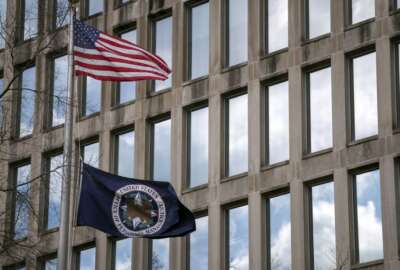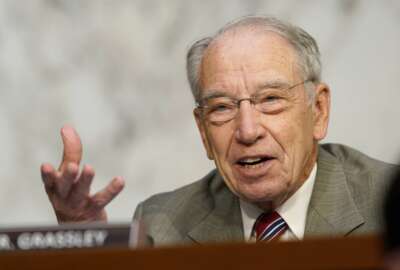Hubbard Radio Washington DC, LLC. All rights reserved. This website is not intended for users located within the European Economic Area.
On Air: Federal News Network
Trending:
EPA, USDA break through small business contracting barriers
The federal government as a whole has consistently missed its goal to award 23 percent of its contract dollars to small businesses. But the government also h...
(This story is part two of Federal News Radio’s special report, The Small Business Dilemma.)
Despite the federal government’s less than stellar record of meeting small business contracting goals over the past six years, the Environmental Protection Agency and the Agriculture Department are two of the exceptions.
EPA, USDA and several other agencies have shown that success in awarding prime contracts to small businesses takes an approach that requires top-down oversight and a bottom-up focus.
In part two of Federal News Radio’s special report, The Small Business Dilemma, Federal News Radio examines why agencies are successful in meeting or surpassing their small business targets.
EPA is taking a “think small first” strategy to contracting. It exceeded its small business prime contract goal of 42 percent last year, with nearly 70 percent of subcontracts going to small firms.

“We want to go small first and justify going large.”
— Jeanette Brown,
OSDBU, Environmental Protection Agency
“We want to go small first and justify going large,” said Jeanette Brown, director of EPA’s Office of Small and Disadvantaged Business Utilization.
EPA attributes its small business contracting success to efforts to elevate OSDBU’s visibility. Brown said she is known as the “small business lady” at her agency.
“People see me as I walk through the agency and will talk to me about [small business contracting] opportunities. The leadership knows, as well as the other staff, pretty much what my role is and how we work in the agency to support and advocate for small businesses,” she said.
That visibility comes partly from the agency’s organizational structure — Brown is a member of the Senior Executive Service and reports directly to the agency’s deputy administrator, as required by the Small Business Act.
At EPA, the role of small business specialists — sprinkled throughout the agency — helps ensure small firms are front-of-mind for program and acquisition offices.
In its regional offices, the small business specialist is part of the acquisition workforce and involved from the beginning in any acquisition forecast. Adrianne Callahan, small business manager for EPA’s Region 5 based in the Midwest, said she tries to understand what the project is and determine where small businesses can fit into that project.
“There may be some [small businesses] that can’t do it at this time, so it’s my job to get the ball rolling. When I’m doing outreach, start talking to these businesses to see what are their capabilities, what are their qualifications, help them understand this is what EPA’s priorities are,” Callahan said.
Agencies that met small business goal in FY2011:*
USAID
Agriculture
Commerce
HHS
Homeland Security
Interior
Labor
State
Transportation
NRC
SBA
SSA
Treasury
EPA
GSA
*Goal varies by agency, with 23 percent as the governmentwide goal.
At the Agriculture Department, each of its 11 buying agencies has a small business coordinator or small business specialist, said Joe Ware, the deputy director of OSDBU at USDA.
USDA also involves its small business office in a procurement from the beginning of the process, rather than waiting right before the solicitation, Ware said.
“We’ve found that to be very, very effective and very helpful both to the agencies and to the small businesses,” he said. “It avoids delays at the end of the solicitation cycle and it provides a good set of solid strategies for the agency to work with.”
Last year, USDA reached its small business contracting goal with more than 52 percent of prime contracts going to small businesses.
The ability to reach out to small firms is easier at USDA — with field offices throughout the country. The Forest Service, for example, had more than 31,000 contract actions totaling $700 million, with nearly 80 percent awarded to small businesses, Ware said.
Some agencies, however, do not have missions that are as small business- accessible. For example, half of the Energy Department’s procurement budget is tied up in contracts with its 17 national laboratories, so those prime contracts cannot go to small firms, said Energy’s OSDBU Director Dot Harris.
The labs “technically are our primes for those sites. When we look at our small businesses, it’s typically in a subcontracting mode,” Harris said.
Energy is the the second-largest buyer in the government, after the Defense Department, and the biggest civilian agency spender. Last year, the department received a grade of ‘F’ from the Small Business Administration for missing its small business contracting goals. Energy’s goal was 6 percent but it only reached 5.33 percent. It also missed all of the subcategory goals of 5 percent for women-owned, 5 percent for small disadvantaged businesses and 3 percent for HUBZone and service-disabled veteran-owned businesses.
Energy is using a dashboard internally at the agency to track small business contracting progress with “red, yellow, green” ratings, Harris said.
With five months on the job, Harris already has met with top leaders to discuss instituting a small-first policy. That policy is currently under review.
The goal of the policy is “simply making sure we’ve evaluated small businesses first … prior to committing [a contract] to any other potential provider,” Harris said.
Greater accountability
The Obama administration started a quarterly interagency meeting with deputies and small business contracting heads to share best practices. One of the ideas to come out of those meetings was to tie senior executives’ performance evaluations to an agency’s small business contracting goals.

“These small businesses can literally come into our labs, incubate their ideas and technology, and then be able to commercialize that for viable products or services for the market.”
— Dot Harris,
OSDBU, Energy Department
Joe Jordan, administrator for the Office of Federal Procurement Policy, said consideration of small business goals in top officials’ bonuses has been “a good driver, good motivator, good incentive of positive performance.”
EPA has taken this best practice a step further by including small business in employees’ evaluations even if they are not an SES member. The weight of the small business goal depends on the employee’s level of decision-making in the contracting process, said EPA’s Brown.
“Of course, it is a goal,” Brown said. “We cannot guarantee that we will be able to meet it, but based on where the agency is and what the numbers have shown, we’re well above the … national goal of 23 percent.”
Some from the small business contracting community and Congress have called for more tangible accountability measures. A bill in the House would put agency leaders’ bonuses on the hook if the agency does not meet its small business contracting goals.
“I think there’s a broad definition of what is accountable,” Jordan said. “I don’t think it makes sense to have some sort of automatic, thoughtless trigger of a particular penalty without any discussion of what actually happened. Why did you miss your goal?”
Jordan said the current “robust scorecard” released each year by the SBA offers a transparent, quantitative way to grade agencies’ small business contracting. The quarterly White House meetings also hold agencies accountable to the senior administration leaders, said Jordan, who used to be the associate administrator for government contracting and business development at SBA before coming to OFPP.
“So, maybe the first time you ask a question [about small business contracting], bad news comes up. But the second time — now they’ve had time to realize this is a real priority of the administration and their senior leadership — the answers are much better… The data is better, the performance is better,” Jordan said.
Outreach and education
As a large, decentralized agency, Agriculture’s contracting points of contact can be confusing for potential contractors.

“As a small business comes into USDA to do business, they need assistance in understanding the USDA landscape for the best potential for their business.”
— Joe Ware,
Deputy OSDBU, USDA
“The biggest challenge is the initial entry into USDA. … As a small business comes into USDA to do business, they need assistance in understanding the USDA landscape for the best potential for their business. We work with them to identify key contract areas, programs that are more suitable to the business they have, as well as the program officials they need to meet with,” said USDA’s Ware.
USDA hit each of its subcategory goals in 2011 except for one — awarding 3 percent of its prime contracts to service-disabled veteran- owned businesses. The agency has a networking event each year specifically to identify these companies. Last November, 150 companies attended the event with top officials from USDA, Ware said.
This year’s event will be held Nov. 8 in Washington. The demand was so high that the attendance list exceeded the 200 guest maximum and now USDA plans to hold another networking event in January, Ware said.
Similarly, EPA is doing additional outreach to firms in Historically Underutilized Business Zones (HUBZones), where it missed its small business contracting sub- goal.
Many HUBZone businesses do not meet EPA’s needs as an emergency responder, Brown said. The 2010 Census also redesignated HUBZones, eliminating about 30 percent of firms previously certified by SBA, causing more challenges for agencies. One solution has been for EPA to team with the National HUBZone Council to identify firms in these areas.
Energy is taking an approach that is “a little more out of the box,” Harris said. Instead of working only with its labs, Energy is looking at ways to bring small businesses into the labs to turn Energy patents into commercial product use.
“These small businesses can literally come into our labs, incubate their ideas and technology, and then be able to commercialize that for viable products or services for the market,” Harris said.
MORE STORIES FROM THE SPECIAL REPORT
DoD carries weight of governmentwide small business goal
HUBZone program in transition after losing 30 percent of firms
Full Coverage of special report: The Small Business Dilemma
Copyright © 2024 Federal News Network. All rights reserved. This website is not intended for users located within the European Economic Area.




